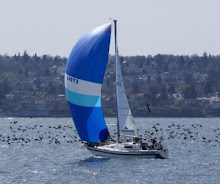
After a long delay I finally used my Google Earth link that I installed months ago. Here are a few saved images from that source. This resource is great for planning trips, finding a place or just seeing what different areas of the globe look like. Google Earth, together with Google Maps, have great potential. The image (north is at the top) above is of northeastern Poland and the Kaliningrad Oblast (region) of Russia. This is the region where my family comes from. With the changes that took place in 1945 and immediately afterward they were expelled from a region that has family links going back hundreds of years and for some, such as my Old Prussian ancestors, perhaps thousands of years. My grandmother and an aunt died on a freight train of malnutrition near Torun (Thorn) on their way to western Germany in October 1945. Another aunt was lost some where in eastern Germany. It wasn't until the 1990s that I learned that only Poles were allowed food rations. Germans waited for months for transportation to be arranged. The lucky ones had either escaped or were evacuated before WWII ended. Those in the northern half of East Prussia, or what later became the Kaliningrad Oblast, most were taken to Koenigsberg, now Kaliningrad, and sent west from there. The unlucky ones were sent east to Siberia. However, it should be remembered that many suffered, Poles, Russians, and others, not just Germans. The history and culture of the region changed for ever after 1945. Hopefully mankind can learn from other peoples' mistakes and learn to live with each other in peace but it appears we go through the same cycle of upheaval and death from one generation to the next and from one region of the globe to another. Anyway, that is where my family comes from for better or for worse. So enough of this and let get on to something more positive!

The view in the image above is of the CN Tower and the Sky Dome in downtown Toronto, Ontario. At one time during the 1990s I used to work in Toronto's downtown and could see the tower when I looked south down the street. Odd thing is, I had never been up to the top of the CN Tower while I worked in Toronto. The first two times was before I lived there and the third time was after I left the city to return to London, Ontario. The feeling was that I always had the time to visit so the time never came. The Science Centre was another such case.

Now here is London, Ontario where I lived until I moved west permanently in February 2006. The top of the image is actually facing toward the southwest. I don't regret the change of venue, although there have been some challenges along the way but nothing that can't be resolved. They say a change is as good as a rest! I don't know whether that's necessarily true but that's the saying. The next three images are of the Cascade Mountain Range and of Mount Baker, a volcano, in particular. Washington state is to the north of the yellow line and BC toward the bottom of the frame. The first two are Google Earth images and the final one is a photos of Mt. Baker taken from my balcony on a sunny day. I will feature other Google Earth images as the mood strikes. I hope you enjoy these.



Note: The view of the volcano is lovely but luckily the mountain has not been active for a while though it does rumble on occasion from what I have been told!
 This image of the Carnica bee on Soldago was taken by Frank Mikley, 2006-06-09.
This image of the Carnica bee on Soldago was taken by Frank Mikley, 2006-06-09. This image of Bees-wings is from PD Photo.org.
This image of Bees-wings is from PD Photo.org. Photo, Honeybee landing on Milkthistle, was taken by Fir0002. All images are from the Wikipedia Commons under the GNU Free Documentation License. See these and other photos plus details on the Western honey bee or European honey bee [Apis mellifera] at:
Photo, Honeybee landing on Milkthistle, was taken by Fir0002. All images are from the Wikipedia Commons under the GNU Free Documentation License. See these and other photos plus details on the Western honey bee or European honey bee [Apis mellifera] at:














































